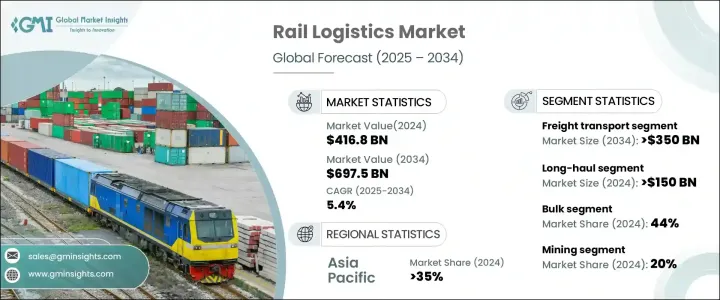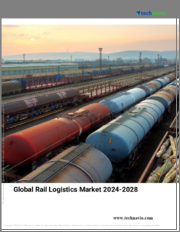
|
시장보고서
상품코드
1698239
철도 물류 시장 : 시장 기회, 성장 촉진요인, 산업 동향 분석, 예측(2025-2034년)Rail Logistics Market Opportunity, Growth Drivers, Industry Trend Analysis, and Forecast 2025 - 2034 |
||||||
세계의 철도 물류 시장은 2024년에 4,168억 달러에 이르렀으며, 2025-2034년 연평균 복합 성장률(CAGR) 5.4%로 성장할 것으로 예측됩니다.
이 성장에는 비용 대비 효과가 높고 효율적인 운송 솔루션에 대한 수요 증가가 박차를 가하고 있으며, 철도 물류는 다른 화물 운송 수단을 대체하는 중요한 옵션으로 자리매김하고 있습니다. 세계 기업들이 장거리에서 대량의 화물을 경쟁가격으로 운송하는 철도 시스템에 대한 의존도를 높이고 있으며, 철도 물류는 세계 무역에 필수적인 기둥이 되고 있습니다. 철도망이 벌크 상품, 제조품, 복합 일관 수송을 높은 연비 효율과 저탄소 배출로 수송할 수 있는 것이 업계 확대의 원동력이 되고 있습니다.

정부와 민간 기업은 철도 인프라에 많은 투자를 하고, 네트워크를 현대화하고, 물류 업무를 간소화하기 위해 디지털 기술을 도입하고 있습니다. 실시간 추적, 자동화, AI 주도 공급망 관리 등의 혁신이 철도 물류 부문을 변화시켜 업무 효율을 향상시키고 원활한 상품 이동을 실현하고 있습니다. 또한 국제 무역 회랑의 확대, 국경을 넘은 연결성, 복합 일관 운송 솔루션은 세계 공급망에서 철도의 전략적 역할을 강화하고 있습니다. 지속가능성과 비용 절감에 대한 관심이 높아지는 가운데, 산업계는 보다 환경 친화적이고 신뢰성 있는 운송 수단으로서 철도 물류에 주목하여 시장의 상승 궤도를 더욱 뒷받침하고 있습니다.
| 시장 범위 | |
|---|---|
| 시작 연도 | 2024년 |
| 예측 연도 | 2025-2034년 |
| 시작 금액 | 4,168억 달러 |
| 예측 금액 | 6,975억 달러 |
| CAGR | 5.4% |
철도 물류 시장은 화물 운송, 창고, 복합 일관 운송, 공급망 관리 및 디지털 솔루션과 같은 주요 서비스로 구분됩니다. 화물 수송은 여전히 지배적인 부문으로 2024년 전체 시장 점유율의 절반 이상을 차지했으며, 이 부문은 2034년까지 3,500억 달러를 창출할 것으로 예측하고 있습니다. 철도 화물은, 도로 수송 및 항공 수송을 대신하는 비용 효율 및 에너지 효율이 뛰어난 수송 수단으로서 계속 대량의 화물 수송에 이용되고 있습니다. 광업, 농업, 제조업 등의 업계는 필수불가결한 상품이나 완제품을 광대한 거리를 효율적으로 이동시키기 위해 철도 물류에 크게 의존하고 있습니다.
철도 물류 산업에서 화물 운송은 벌크 화물, 액체 화물, 컨테이너 화물, 자동차 화물, 온도 관리 화물로 분류됩니다. 벌크 화물은 시장을 리드해, 2024년에는 44%의 점유율을 차지했습니다. 석탄, 곡물, 광물 등의 상품이 이 부문을 지배하고 있으며 최소한의 연료 소비 및 안전성 강화로 장거리를 대량으로 수송할 수 있는 철도 능력의 혜택을 받고 있습니다. 벌크 화물의 성질과 양을 고려할 때 철도는 여전히 가장 실행 가능한 운송 수단이며 에너지, 광업, 농업 등의 산업에서 중요한 역할을 하고 있습니다.
2024년 시장 점유율은 아시아태평양이 35%를 차지했으며, 철도 물류 성장의 주요 거점으로 자리매김하고 있습니다. 이 지역의 확대는 주로 철도 인프라에 대한 다액의 투자와 국제 무역의 연결성 중시의 고조에 의해 초래되고 있습니다. 아시아 태평양 국가들은 벌크 상품과 제조품의 효율적인 수송을 촉진하기 위해 철도망의 근대화를 추진하고 있으며, 지역 및 세계 물류에서 철도의 중요한 역할을 강화하고 있습니다.
목차
제1장 조사 방법 및 조사 범위
- 조사 디자인
- 조사 접근
- 데이터 수집 방법
- 기본 추정 및 계산
- 기준 연도의 산출
- 시장추계의 주요 동향
- 예측 모델
- 1차 조사 및 검증
- 시장 범위 및 정의
제2장 주요 요약
제3장 업계 인사이트
- 생태계 분석
- AI 소프트웨어 제공업체
- 서비스 제공업체
- 데이터 제공업체
- 시스템 통합자
- 최종 용도
- 공급자의 상황
- 이익률 분석
- 기술 및 혁신의 전망
- 특허 분석
- 주요 뉴스 및 대처
- 규제 상황
- 사례 연구
- 영향요인
- 성장 촉진요인
- 전자상거래 및 국경을 넘은 무역의 급성장
- 안전하고 효율적인 운송 시스템에 대한 수요 증가
- 철도 인프라에 대한 예산 배분 증가
- AI, IoT, 자율주행열차의 대두 등, 철도의 기술적 진보
- 업계의 잠재적 위험 및 과제
- 고액의 설비 투자 및 긴 투자 회수 기간
- 인프라 노후화 및 유지보수 문제
- 성장 촉진요인
- 성장 가능성 분석
- Porter's Five Forces 분석
- PESTEL 분석
제4장 경쟁 구도
- 서문
- 기업 점유율 분석
- 경쟁 포지셔닝 매트릭스
- 전략 전망 매트릭스
제5장 시장 추계 및 예측 : 서비스별(2021-2034년)
- 주요 동향
- 화물 수송
- 창고업
- 복합 일관 수송
- 공급망 관리
- 디지털 솔루션
제6장 시장 추계 및 예측 : 화물별(2021-2034년)
- 주요 동향
- 벌크
- 액체
- 컨테이너
- 자동차
- 온도 관리 상품
제7장 시장 추계 및 예측 : 거리별(2021-2034년)
- 주요 동향
- 단거리
- 중거리
- 장거리
제8장 시장 추계 및 예측 : 최종 용도별(2021-2034년)
- 주요 동향
- 광업
- 농업
- 에너지
- 제조업
- 건설
- 소매업
- 자동차
- 화학
- 음식
- 기타
제9장 시장 추계 및 예측 : 지역별(2021-2034년)
- 주요 동향
- 북미
- 미국
- 캐나다
- 유럽
- 영국
- 독일
- 프랑스
- 이탈리아
- 스페인
- 러시아
- 북유럽
- 아시아태평양
- 중국
- 인도
- 일본
- 호주
- 한국
- 동남아시아
- 라틴아메리카
- 브라질
- 멕시코
- 아르헨티나
- 중동 및 아프리카
- UAE
- 남아프리카
- 사우디아라비아
제10장 기업 프로파일
- Aurizon
- BNSF Railway
- Canadian National Railway(CN)
- Canadian Pacific Kansas City(CPKC)
- China Railway Freight
- CSX Transportation
- Deutsche Bahn(DB Cargo)
- Euro Cargo Rail
- Ferromex
- Genesee & Wyoming
- Indian Railways
- Japan Freight Railway Company(JR Freight)
- Kansas City Southern(KCS)
- Norfolk Southern Railway
- OBB Rail Cargo Group
- PKP Cargo
- Russian Railways(RZD)
- SNCF Logistics
- Union Pacific Railroad
- VTG
The Global Rail Logistics Market reached USD 416.8 billion in 2024 and is projected to grow at a CAGR of 5.4% between 2025 and 2034. This growth is fueled by the rising demand for cost-effective and efficient transportation solutions, positioning rail logistics as a critical alternative to other freight transport methods. Businesses worldwide are increasingly relying on rail systems to move large volumes of goods over long distances at competitive prices, making rail logistics an essential pillar of global trade. The ability of rail networks to transport bulk commodities, manufactured goods, and intermodal shipments with high fuel efficiency and lower carbon emissions is driving industry expansion.

Governments and private enterprises are making significant investments in rail infrastructure, modernizing networks, and deploying digital technologies to streamline logistics operations. Innovations such as real-time tracking, automation, and AI-driven supply chain management are transforming the rail logistics sector, improving operational efficiency and ensuring seamless goods movement. Additionally, the expansion of international trade corridors, cross-border connectivity, and intermodal solutions is reinforcing the strategic role of rail in global supply chains. With increasing concerns over sustainability and cost reduction, industries are turning to rail logistics as a more eco-friendly and reliable transport mode, further propelling the market's upward trajectory.
| Market Scope | |
|---|---|
| Start Year | 2024 |
| Forecast Year | 2025-2034 |
| Start Value | $416.8 Billion |
| Forecast Value | $697.5 Billion |
| CAGR | 5.4% |
The rail logistics market is segmented into key services, including freight transport, warehousing, intermodal logistics, supply chain management, and digital solutions. Freight transport remains the dominant segment, accounting for over half of the total market share in 2024, with forecasts indicating that this segment will generate USD 350 billion by 2034. Rail freight continues to be the preferred mode for transporting large volumes of goods, offering a cost-effective and energy-efficient alternative to road and air transport. Industries such as mining, agriculture, and manufacturing heavily depend on rail logistics to move essential commodities and finished products efficiently across vast distances.
Cargo transportation in the rail logistics industry is further categorized into bulk, liquid, containers, automotive, and temperature-controlled goods. Bulk cargo leads the market, holding a 44% share in 2024. Commodities such as coal, grains, and minerals dominate this segment, benefiting from rail's ability to transport large quantities over long distances with minimal fuel consumption and enhanced safety. Given the nature and volume of bulk goods, rail remains the most viable transportation mode, playing a crucial role in industries like energy, mining, and agriculture.
Asia Pacific held a 35% market share in 2024, positioning itself as a major hub for rail logistics growth. The region's expansion is primarily driven by substantial investments in rail infrastructure and an increasing emphasis on international trade connectivity. Countries across the Asia Pacific are modernizing their rail networks to facilitate the efficient transportation of bulk commodities and manufactured goods, reinforcing rail's critical role in regional and global logistics.
Table of Contents
Chapter 1 Methodology & Scope
- 1.1 Research design
- 1.1.1 Research approach
- 1.1.2 Data collection methods
- 1.2 Base estimates & calculations
- 1.2.1 Base year calculation
- 1.2.2 Key trends for market estimation
- 1.3 Forecast model
- 1.4 Primary research and validation
- 1.4.1 Primary sources
- 1.4.2 Data mining sources
- 1.5 Market scope & definition
Chapter 2 Executive Summary
- 2.1 Industry synopsis, 2021 - 2034
Chapter 3 Industry Insights
- 3.1 Industry ecosystem analysis
- 3.1.1 AI software providers
- 3.1.2 Service providers
- 3.1.3 Data providers
- 3.1.4 System integrators
- 3.1.5 End use
- 3.2 Supplier landscape
- 3.3 Profit margin analysis
- 3.4 Technology & innovation landscape
- 3.5 Patent analysis
- 3.6 Key news & initiatives
- 3.7 Regulatory landscape
- 3.8 Case studies
- 3.9 Impact forces
- 3.9.1 Growth drivers
- 3.9.1.1 Rapid growth of e-commerce and cross-border trade
- 3.9.1.2 Rise in demand for secure, safer, and efficient transport systems
- 3.9.1.3 Increase in allocation of budget for railway infrastructure
- 3.9.1.4 Technological advancement in railways such as AI, IoT and rise of autonomous trains
- 3.9.2 Industry pitfalls & challenges
- 3.9.2.1 High capital investment and long ROI period
- 3.9.2.2 Aging infrastructure and maintenance issues
- 3.9.1 Growth drivers
- 3.10 Growth potential analysis
- 3.11 Porter’s analysis
- 3.12 PESTEL analysis
Chapter 4 Competitive Landscape, 2024
- 4.1 Introduction
- 4.2 Company market share analysis
- 4.3 Competitive positioning matrix
- 4.4 Strategic outlook matrix
Chapter 5 Market Estimates & Forecast, By Service, 2021 - 2034 ($Bn)
- 5.1 Key trends
- 5.2 Freight transport
- 5.3 Warehousing
- 5.4 Intermodal logistics
- 5.5 Supply chain management
- 5.6 Digital solutions
Chapter 6 Market Estimates & Forecast, By Cargo, 2021 - 2034 ($Bn)
- 6.1 Key trends
- 6.2 Bulk
- 6.3 Liquid
- 6.4 Containers
- 6.5 Automotive
- 6.6 Temperature-controlled goods
Chapter 7 Market Estimates & Forecast, By Distance, 2021 - 2034 ($Bn)
- 7.1 Key trends
- 7.2 Short haul
- 7.3 Medium-haul
- 7.4 Long-haul
Chapter 8 Market Estimates & Forecast, By End Use, 2021 - 2034 ($Bn)
- 8.1 Key trends
- 8.2 Mining
- 8.3 Agriculture
- 8.4 Energy
- 8.5 Manufacturing
- 8.6 Construction
- 8.7 Retail
- 8.8 Automotive
- 8.9 Chemical
- 8.10 Food & beverages
- 8.11 Others
Chapter 9 Market Estimates & Forecast, By Region, 2021 - 2034 ($Bn)
- 9.1 Key trends
- 9.2 North America
- 9.2.1 U.S.
- 9.2.2 Canada
- 9.3 Europe
- 9.3.1 UK
- 9.3.2 Germany
- 9.3.3 France
- 9.3.4 Italy
- 9.3.5 Spain
- 9.3.6 Russia
- 9.3.7 Nordics
- 9.4 Asia Pacific
- 9.4.1 China
- 9.4.2 India
- 9.4.3 Japan
- 9.4.4 Australia
- 9.4.5 South Korea
- 9.4.6 Southeast Asia
- 9.5 Latin America
- 9.5.1 Brazil
- 9.5.2 Mexico
- 9.5.3 Argentina
- 9.6 MEA
- 9.6.1 UAE
- 9.6.2 South Africa
- 9.6.3 Saudi Arabia
Chapter 10 Company Profiles
- 10.1 Aurizon
- 10.2 BNSF Railway
- 10.3 Canadian National Railway (CN)
- 10.4 Canadian Pacific Kansas City (CPKC)
- 10.5 China Railway Freight
- 10.6 CSX Transportation
- 10.7 Deutsche Bahn (DB Cargo)
- 10.8 Euro Cargo Rail
- 10.9 Ferromex
- 10.10 Genesee & Wyoming
- 10.11 Indian Railways
- 10.12 Japan Freight Railway Company (JR Freight)
- 10.13 Kansas City Southern (KCS)
- 10.14 Norfolk Southern Railway
- 10.15 OBB Rail Cargo Group
- 10.16 PKP Cargo
- 10.17 Russian Railways (RZD)
- 10.18 SNCF Logistics
- 10.19 Union Pacific Railroad
- 10.20 VTG














